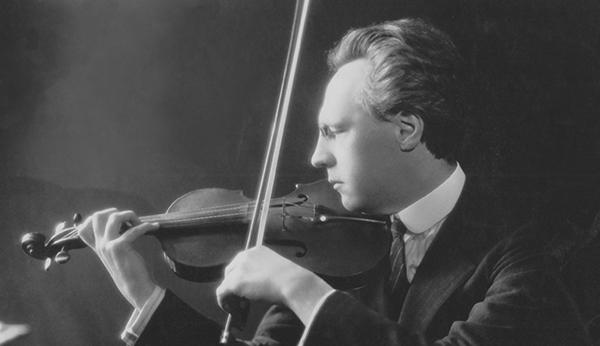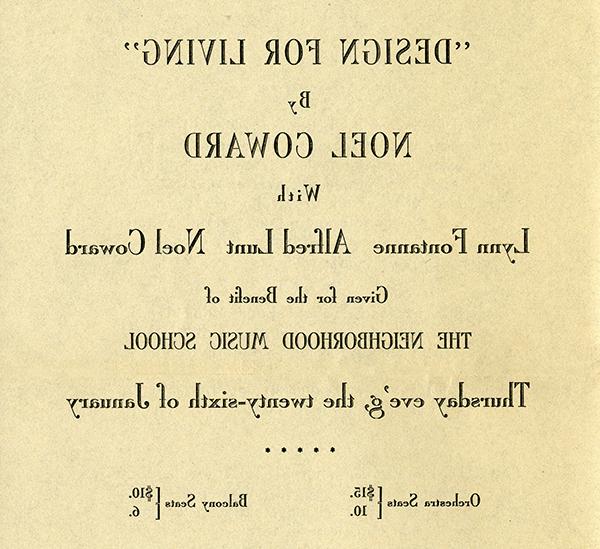This information is arranged by year and includes MSM historical and other highlights of New York City’s music history.
1913

Janet Daniels, a young musician and graduate of the New York School of Social Work, begins teaching music at the Union Settlement on East 104th Street in Manhattan.
1917
Due to the events of World War I, the Union Settlement notifies Janet Daniels Schenck that they can no longer support the Music School financially. She establishes an independent Board which keeps the School going. She is director from 1918–1956.
1918

One of the oldest surviving items from the School’s history, showing ledger entries for receipts and disbursements from January/February 1918, when Manhattan School of Music was still known as the Union Settlement Music School.

In March, Harold Bauer and Pablo Casals become the founding members of the artist auxiliary board.
A budget of $3,000 for 1918–1919 is approved by the new Board of Trustees.
There are 120 students, representing 10 nationalities, and a faculty of 23. The fee charged is 50 cents a lesson or 25 cents with two in a class.
Other Highlights of New York City Musical History:
- Louis (Leonard) Bernstein is born in Lawrence, Massachusetts, on August 25.
- Sergei Rachmaninoff moves to New York.
- Rosa Ponselle makes Metropolitan Opera debut in La forza del destino.
- The Harlem Hellfighters, James Reese Europe’s 369th Regiment band, with Rafael Hernandez (who will become known as Puerto Rico’s greatest composer) and 17 other Puerto Rican soldiers, records 21 songs and is the first group to play ragtime and jazz in Europe.
1919
The first District Music Service begins, currently known as community outreach, with concerts given at various divisions of Ellis Island, including the tuberculosis and psychopathic wards. Surgical and shell-shock hospitals are visited weekly.
Other Highlights of New York City Musical History:
- George Gershwin, 19, writes “Swanee,” with lyrics by Irving Caesar, featuring 60 chorus girls with electric light bulbs attached to their slippers (Capitol Theater).
- Irving Berlin incorporates Irving Berlin Music Corp. to publish his own music.
- Charles Griffes’ Poem for Flute and Orchestra is premiered by soloist Georges Barrère and the Symphony Society of New York (New York Philharmonic) on November 16.
1920
The School’s first charter is issued. The School is incorporated as the Neighborhood Music School under the Board of Regents of the University of the State of New York.
The School has 200 students.
Other Highlights of New York City Musical History:
- Enrico Caruso gives last public performance in La juive at Metropolitan Opera.
- Jazz pianist (James) Fletcher Henderson, 23, begins playing piano on a Hudson riverboat and works as a plugger for a sheet music company.
- The Ziegfeld Follies, music and lyrics by Irving Berlin, opens with Fanny Brice and W.C. Fields at the New Amsterdam Theater (123 performances).
- Gertrude ‘Ma’ Rainey, Bessie Smith (“Empress of the Blues”), Alberta Hunter, and Ethel Waters introduce the blues to Harlem.
1921

In October 1921, the Board of Trustees purchases a building from the Jewish Guild for the Blind, giving the Neighborhood Music School its first real home, at 238 East 105th Street. The building would later be replaced by larger facilities at the same address as surrounding properties became available, and the name would be changed to Manhattan School of Music.
Other Highlights of New York City Musical History:
- Constance Keene (former MSM piano faculty) born in Brooklyn, February 9.
- Edgar Varèse organizes International Composers’ Guild to promote the cause of 20th-century music.
- Shuffle Along, music by Eubie Blake, starring Florence Mills and teenaged Josephine Baker, opens at the 63rd Street Music Hall (504 performances).
1922
May — The first commencement is held and the first diploma awarded.

Hugo Kortschak joins the conducting and string faculties, where he remains for 30 years.
Other Highlights of New York City Musical History:
- Edwin Franco Goldman’s New York Military Band moves outdoor summer concerts to Central Park Mall.
- New York Philharmonic conducted by Willem Mengelberg makes first recording for the Victor, Co.
1923

Metropolitan Opera star Dusolina Giannini (sister of composer, Vittorio) visits the School as a special guest.
Famed violinist Fritz Kreisler joins the School’s Auxiliary Board and his colleagues Harold Bauer and Pablo Casals, who joined in 1918.
The first concert in a public hall is performed in the Heckscher Theatre in May.
Other Highlights of New York City Musical History:
- Bruno Walter makes American debut conducting New York Symphony Orchestra in Carnegie Hall.
- Cotton Club opens at Lexington Avenue and 142nd Street.
- Maria Callas born in NYC, December 2.
- Louis Armstrong debuts at Harlem’s Lafayette Theater as a member of Fletcher Henderson’s Big Band.
1924
The first Town Hall recital is given in January.
There are 246 students representing 14 nationalities, with 244 on the waiting list, 28 teachers, and a budget of $19,854.37.
Pianist Harold Bauer gives his first master class in the fall.
Other Highlights of New York City Musical History:
- Composer Ezra Laderman is born in Brooklyn on June 29.
- Paul Whiteman commissions George Gershwin to write Rhapsody in Blue, premiered by Gershwin at the piano and Paul Whiteman’s orchestra at Aeolian Hall.
- Lady Be Good by George and Ira Gershwin opens with Fred and Adele Astaire at the Liberty Theater. Songs include “Somebody Loves Me,” “The Man I Love,” and “Fascinating Rhythm.”
1925
The School’s first concert hall is constructed, seating over two hundred people.
In November, the Board of Regents of the University of the State of New York grants the School’s permanent charter.
Other Highlights of New York City Musical History:
- New York Philharmonic and conductor Walter Damrosch premiere Symphony for Organ and Orchestra by Brooklyn-born Aaron Copland, featuring organist Nadia Boulanger.
- George Gershwin’s Concerto in F premiered (Carnegie Hall).
- Paul Robeson gives first concert recital, consisting solely of spirituals, at the Greenwich Village Theater.
- Contralto Marian Anderson makes her debut with the New York Philharmonic at Lewisohn Stadium.
1926

Dora Zaslavsky, one of the first graduates of the School, joins the piano faculty, where she teaches for over 60 years.

Music Youth & Opportunity: A Survey of Settlement and Community Music Schools is published, authored by Janet D. Schenck
Other Highlights of New York City Musical History:
- Metropolitan Opera gives American premiere of Puccini’s Turandot, with Maria Jeritza and more than 650 performers on stage.
- Tony Bennett (Anthony Dominick Benedetto) born in Astoria, Queens, August 3.
- Fats Waller records organ solos in New York.
- Walter W. Naumburg establishes a foundation “to give public hearings for deserving music students.”
1927
Philanthropist Mrs. John Hubbard offers to gift the School a modern new building under three conditions: that the $23,000 mortgage on the old property be paid off; that yearly guarantees amounting to a total of $100,000 be raised to cover the next ten years; and that an Endowment Fund be started.
Other Highlights of New York City Musical History:
- The Jazz Singer starring Al Jolson, produced by Darryl F. Zanuck, is first sound movie released.
- New York-born prodigy Yehudi Menuhin, 11, makes Carnegie Hall debut.
- Harry Belafonte born in Harlem, March 1.
- Showboat, music by Jerome Kern, lyrics by Oscar Hammerstein II, starring Paul Robeson singing “Ol’ Man River,” opens at the Ziegfeld Theater (527 performances).
- Pianist Charlie Palmieri born in NYC, November 21.
1928

The School moves into a new four-story building, built on the same site as the old.

A benefit concert for the School is given by the Philharmonic Society of New York (now the New York Philharmonic) at the Metropolitan Opera House conducted by Arturo Toscanini.
There are 28 theory classes; 20 scholarship students; Senior Orchestra numbers 28.
Other Highlights of New York City Musical History:
- Concert by the Philharmonic Society of New York conducted by Arturo Toscanini benefits Janet Schenck’s Neighborhood Music School.
- Bela Bartók makes American debut performing Rhapsody, op. 1 for piano with New York City Symphony Orchestra conducted by Willem Mengelberg.
- Composer Nicolas Flagello born NYC, March 15 (MSM faculty 1950–77, MSM alumnus).
- Vladimir Horowitz, 23, and contralto Marian Anderson, 31, make Carnegie Hall debuts.
1929
In April, the new building is dedicated and a concert and reception is held for Mrs. Hubbard (delayed because of her travel plans); Harold Bauer performs Bach, Schumann, and Brahms.
Other Highlights of New York City Musical History:
- Ezio Pinza sings Don Giovanni at the Metropolitan Opera.
- WNYC begins airing Masterwork Hour, which will become radio’s oldest recorded program of fine music.
- Beverly Sills (Belle Miriam Silverman) born in Brooklyn, May 25.
1930
New library and elevator for the library are added; a reading room is constructed in place of the entrance court.
Hugh Ross, conductor of New York’s Schola Cantorum, joins the faculty, where he remains for over 50 years.
Other Highlights of New York City Musical History:
- Girl Crazy, music by George Gershwin, lyrics by Walter Donaldson and Ira Gershwin, opens at the Alvin Theater (272 performances) and Astoria-born Ethel Merman, 21, knocks ‘em dead with “I Got Rhythm.”
- Stephen Sondheim born in NYC, March 22.
1931

Pianist Ernest Hutcheson gives a recital at the School and meets with students.

At the invitation of Director Janet Schenck, Josephine Culver Whitford joins the staff as assistant registrar, and thus begins an over 50-year association with the School.
Other Highlights of New York City Musical History:
- Samuel Barber composes Dover Beach, op. 3 for voice and string quartet.
- Brill Building opens, with 11 stories occupied by Tin Pan Alley publishers / bandleaders (1619 Broadway).
- Steinway becomes the standard piano used in radio broadcasting.
1932

Invitation for a January 26 performance of Noel Coward’s play to benefit the School.
The School has 320 students representing 18 nationalities; there are 44 teachers on faculty.
Other Highlights of New York City Musical History:
- Duke Ellington writes “It Don’t Mean a Thing, If It Ain’t Got that Swing.”
- Radio City Music Hall opens, housing the largest organ built by Rudolf Wurlitzer, with Morton Gould, 19, as staff pianist.
1933

“Our District Music Service (begun at the School after WWI) had made us aware of endless possibilities in the field of creating audiences as well as training our young people in the field of performance. In 1933 we started weekly concerts at the Museum of the City of New York where we still regularly send musicians for recitals and chamber music concerts.” (from Janet Schenck’s “Adventure in Music”)
In December, representatives from twenty organizations met at the school and discussed ways in which music could be used, still more effectively, in their own centers (concerts, musical programs, and talks on music).
Other Highlights of New York City Musical History:
- Ruth Crawford Seeger’s String Quartet premiered by New World String Quartet at the New School for Social Research.
- Lena Horne, 16, debuts at the Cotton Club.
- Duke Ellington’s “Sophisticated Lady” and Rodgers and Hart’s “I Gotta Get Back to New York” written.
1934
There are 403 students representing 25 nationalities.
As part of the School’s District Music Service, 88 programs of music in 29 different centers are given between February 27 and June 5: 37 programs in educational organizations, 31 in social centers, 15 in health centers, and 5 in churches.
Other Highlights of New York City Musical History:
- Arnold Schoenberg moves to NYC to teach at Malkin Conservatory (stays at the Ansonia Hotel, Broadway and 73rd Street).
- Antonia Brico appointed conductor of the Women’s Symphony Orchestra of New York.
- Harlem’s Apollo Theater opens as a showcase for black performing artists; first year performers include Bessie Smith, Billie Holiday, Dinah Washington, Duke Ellington, Count Basie, and, on “Amateur Night,” 16-year-old Ella Fitzgerald.
- Anything Goes by Cole Porter opens with songs including “I Get a Kick Out of You” and “You’re the Top” at the Alvin Theater (420 performances).
- Glenn Miller joins the Dorsey Brother’s Orchestra and debuts at the Rainbow Room.
1935
“District Music Service” (community outreach) includes 32 concerts at 15 different agencies; 23 additional agencies are reached regularly through concerts, designed especially for the community, and given at the School.
There are 435 students representing 21 nationalities in attendance: 25% are under 12 years of age, 36% between 12 and 18, and 39% over 18 years old (61% under 18 and 39% over 18 years of age).
Other Highlights of New York City Musical History:
- Benny Goodman hires pianist Teddy Wilson for his trio, breaking the racial color line in jazz.
- Max Gordon opens the Village Vanguard jazz club on Seventh Avenue.
- Porgy and Bess by George and Ira Gershwin premieres at the Alvin Theater.
1936

Guest artist Jose Iturbi gives a piano recital for students.
Other Highlights of New York City Musical History:
- Steve Reich born in NYC, October 3.
- Roger Sessions composes his String Quartet No. 1.
- Rudolf Serkin, 32, makes Carnegie Hall debut.
- WQXR begins broadcasting as first U.S. classical radio station.
1937
Guest artists include pianist Robert Casadesus, flutist Rene LeRoy, Swedish mezzo-soprano Gertrud Wettergren, and British pianist Myra Hess.
Other Highlights of New York City Musical History:
- John Brownlee (future MSM president) makes Metropolitan Opera debut.
- Samuel Barber composes First Essay for Orchestra.
- Lukas Foss, 15, moves to New York from Germany.
- NBC Symphony, conducted by Arturo Toscanini, founded.
- Brooklyn-born radio hobbyist Avery Fisher, 31, founds Philharmonic Radio Co., to market improvements he has made to audio designs.
- Babes in Arms by Rodgers and Hart opens with songs including “My Funny Valentine” and “The Lady is a Tramp” at the Shubert Theater (289 performances).
- The Cradle Will Rock, music and book by Marc Blitzstein, direction by Orson Welles, production by John Houseman, opens at the Venice Theater.
1938
Amendment to charter of the Neighborhood Music School renames the institution Manhattan School of Music.
The School has 482 students, 55 scholarship students, 46 theory classes; Senior Orchestra numbers 70.
Other Highlights of New York City Musical History:
- Benny Goodman and his Orchestra give first Carnegie Hall big-band jazz concert.
- Antonia Brico becomes first woman to conduct the New York Philharmonic.
- John Corigliano (MSM alumnus) born in NYC, February 16.
1939

The new Hubbard Auditorium and additional rooms added to the building are completed.

A December performance by the Metropolitan Opera benefited Manhattan School of Music. The production was Wagner’s Tristan und Isolde, with Eric Leinsdorf conducting a cast that included Lauritz Melchior and Kirsten Flagstad.
Other Highlights of New York City Musical History:
- Blue Note Records founded by German-born Alfred Lion and Francis Wolff, who have come to NYC to escape Nazi persecution.
- Billie Holiday performs “Strange Fruit” at Café Society on Sheridan Square.
- Saxophone innovator Charlie Parker moves to NYC, hears pianist Art Tatum at Jimmie’s Chicken Shack.
- Broadcast Music, Inc. (BMI) founded.
Do you have pictures or memories that you’d like to share? Please email us here.
